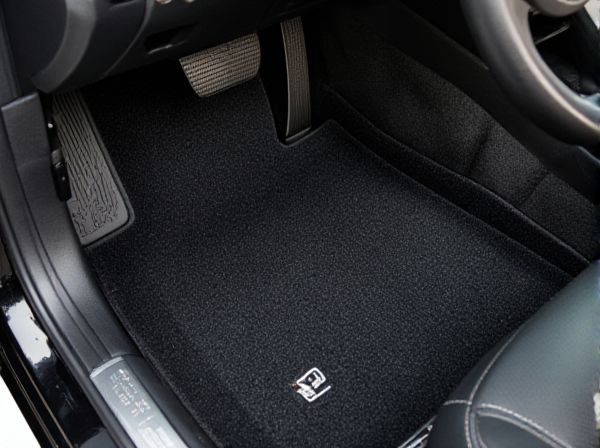
Photo illustration: Synthetic Fiber Carpet vs Natural Fiber Carpet
Synthetic fiber carpets offer durability, stain resistance, and affordability, making them ideal for high-traffic areas and homes with pets or children. Natural fiber carpets, such as wool or coir, provide eco-friendly benefits, superior softness, and natural insulation, enhancing comfort and sustainability in your living space. Your choice depends on balancing ease of maintenance with environmental considerations and desired texture.
Table of Comparison
| Feature | Synthetic Fiber Carpet | Natural Fiber Carpet |
|---|---|---|
| Material | Polypropylene, Nylon, Polyester | Coir, Sisal, Wool |
| Durability | High resistance to wear and stains | Moderate durability, susceptible to moisture |
| Maintenance | Easy to clean and quick drying | Requires careful cleaning, slower drying |
| Comfort | Soft texture, cushioned feel | Natural, coarse texture |
| Cost | Affordable, budget-friendly | Higher initial cost |
| Environmental Impact | Petroleum-based, less eco-friendly | Biodegradable, sustainable |
| Color Variety | Wide range of colors | Limited color options |
Introduction to Carpet Fiber Types
Carpet fibers are primarily categorized into synthetic and natural fibers, each offering distinct properties and benefits. Synthetic fiber carpets, made from materials like nylon, polyester, and olefin, are prized for their durability, stain resistance, and affordability. Natural fiber carpets such as wool, sisal, and jute provide superior softness, insulation, and biodegradability, catering to eco-conscious consumers seeking organic options.
What Are Synthetic Fiber Carpets?
Synthetic fiber carpets are made from man-made materials such as nylon, polyester, olefin, and acrylic, engineered to mimic the appearance and texture of natural fibers. These carpets offer enhanced durability, stain resistance, and affordability compared to natural fiber options. Commonly used in high-traffic areas, synthetic fiber carpets provide versatile design options and require lower maintenance.
Overview of Natural Fiber Carpets
Natural fiber carpets are crafted from renewable resources such as wool, jute, sisal, coir, and seagrass, offering eco-friendly and biodegradable flooring options. Wool carpets provide exceptional durability, stain resistance, and insulation properties, while sisal and jute deliver a firm texture with natural earthy aesthetics perfect for high-traffic areas. These carpets promote indoor air quality by reducing allergens and are preferred for their sustainable sourcing and minimal environmental impact compared to synthetic alternatives.
Durability: Synthetic vs Natural Fiber Carpets
Synthetic fiber carpets, made from materials like nylon, polyester, and olefin, offer superior durability and stain resistance compared to natural fiber carpets such as wool or cotton. Nylon synthetic carpets exhibit excellent wear tolerance and resilience, making them ideal for high-traffic areas, while natural fibers tend to be more susceptible to moisture damage and abrasion. Advances in synthetic fiber technology enhance longevity and ease of maintenance, often exceeding the lifespan of natural fiber options.
Stain Resistance and Maintenance
Synthetic fiber carpets, such as nylon and polyester, offer superior stain resistance due to their non-porous fibers and advanced stain-repellent treatments, making them easier to clean and maintain in high-traffic areas. Natural fiber carpets like wool and sisal absorb moisture more readily, leading to increased susceptibility to stains and requiring specialized cleaning methods to prevent damage. Maintenance of synthetic carpets typically involves routine vacuuming and spot cleaning, whereas natural fiber carpets demand more careful care, including professional cleaning to preserve fiber integrity and appearance.
Comfort and Texture Comparison
Synthetic fiber carpets, such as nylon and polyester, offer a consistently soft texture with greater durability and stain resistance, ideal for high-traffic areas requiring low maintenance. Natural fiber carpets, including wool and sisal, provide superior breathability and a luxurious, plush feel that enhances comfort but may require more care and be prone to wear over time. The choice between these carpet types hinges on balancing the desire for softness and tactile warmth against durability and ease of upkeep.
Environmental Impact and Sustainability
Synthetic fiber carpets, made from petroleum-based products like nylon, polyester, and polypropylene, have a significant environmental footprint due to non-renewable resource extraction and low biodegradability, leading to landfill accumulation. In contrast, natural fiber carpets, such as those made from wool, jute, sisal, and coir, offer enhanced sustainability through biodegradability, renewable sourcing, and lower chemical processing. The environmental impact of carpet choices should consider lifecycle assessments, including resource use, emissions during production, and end-of-life disposal or recycling potential.
Cost Differences: Budget Considerations
Synthetic fiber carpets generally cost 20-50% less than natural fiber carpets, making them a popular choice for budget-conscious homeowners. Materials like nylon or polyester offer affordability without sacrificing durability, whereas natural fibers such as wool or sisal often come with higher upfront costs due to their eco-friendly production and enhanced aesthetic appeal. Maintenance expenses tend to be lower for synthetic carpets due to their stain resistance, contributing to overall cost savings.
Style and Design Options
Synthetic fiber carpets offer a broader range of vibrant colors and intricate patterns due to their enhanced dye absorption and manufacturing flexibility. Natural fiber carpets, such as wool or sisal, provide unique textures and organic aesthetics that add warmth and authenticity to interior spaces. Custom designs are often more achievable with synthetic materials, while natural fibers emphasize handcrafted, artisanal appeal.
Which Carpet Fiber Is Best for Your Space?
Synthetic fiber carpets, such as nylon and polyester, offer superior stain resistance, durability, and affordability, making them ideal for high-traffic areas and homes with pets or children. Natural fiber carpets, including wool, sisal, and jute, provide a luxurious feel, excellent insulation, and eco-friendly benefits but require more maintenance and are prone to staining. Choosing the best carpet fiber depends on your space's usage, desired aesthetic, and maintenance preferences.
 caratoz.com
caratoz.com